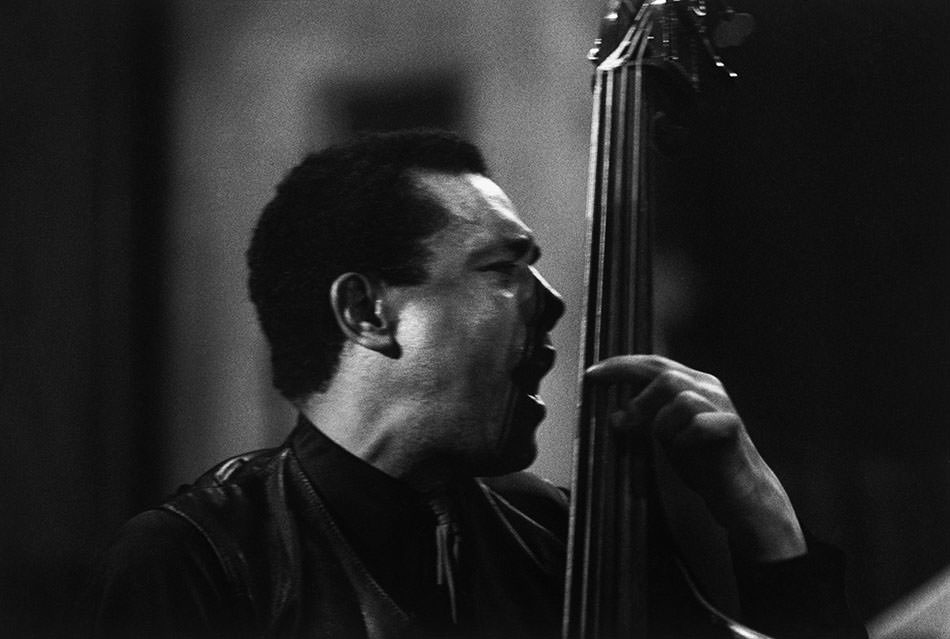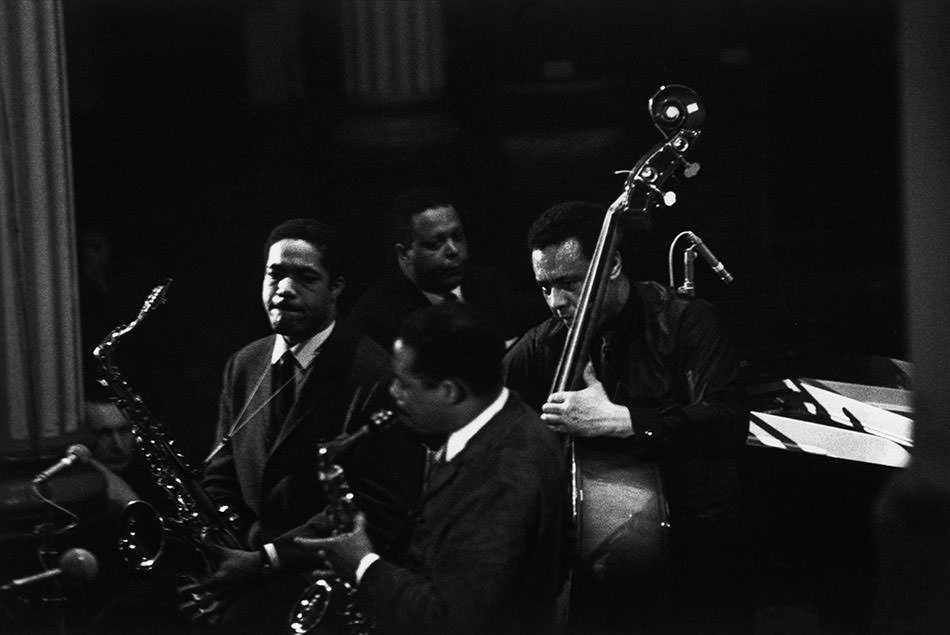Charles Mingus’s audiences never knew quite what they were going to get, and this kept them coming. Mingus, the bassist, composer, and bandleader who reached the height of his fame in the mid-1960s, was notoriously mercurial. He was known to fire and rehire band members over the course of a set, and was once fired himself for chasing a trombonist across the stage with an axe. His reactions to noisy crowds ranged from announcing, “Isaac Stern doesn’t have to put up with this shit,” to ordering his band to read books onstage. His music, which drew omnivorously on the blues, gospel, Dixieland, Duke Ellington, bebop, and classical music, among much else, was similarly unpredictable. It blurred the boundaries between improvisation and composition, often ignoring standard form, and was famous for its rapid shifts in mood and tempo.
Mingus (1922–1979) would have turned ninety last year, and in celebration, Mosaic has released The Jazz Workshop Concerts: 1964–1965, a new box set with rare and previously unreleased performances by some of Mingus’s greatest ensembles. These concerts, recorded near the apex of Mingus’s career, are visceral and often unvarnished. At times, the music here can be forbidding—several tracks run beyond thirty minutes—and though it may not be as uniformly polished as some of his studio albums, at its best this set captures an element of shock and surprise that Mingus’s studio recordings sometimes don’t.
“Mingus music,” as he called it, was so complex and so much an extension of his own personality that it was largely played only by his own group, the Jazz Workshop. Turnover in the Workshop was high, partly because he couldn’t afford to pay his musicians very well, partly because the experience was so grueling (members called it the Jazz Sweatshop), and partly because so many of them, after sharpening their skills with Mingus, went on to lead their own bands (Gary Giddins once called it the Harvard University of Jazz).
Even with Mingus at the helm playing bass (and sometimes piano), Workshop performances often resembled practice sessions more than concerts. He did everything in his power to push his players beyond their limits: while a musician was soloing, he might double the tempo, cut it in half, or drop the accompaniment of the bass, drums, and piano entirely, all without warning. Often, players would buckle under the pressure and songs would grind to a halt, with Mingus screaming recriminations and heaping shame on everyone in sight. But sometimes his musicians would rise to the challenge, and it was the possibility of this transcendence that gave Jazz Workshop performances such an electrifying sense of expectation and adventure.
The ensemble playing on the first four discs of Mosaic’s collection is one of Mingus’s best sextets, including, among others, the drummer Dannie Richmond, one of his longest and closest collaborators; the pianist Jaki Byard; and the brilliant multi-instrumentalist Eric Dolphy, whose solo on “Meditations on Integration” is alone worth the price of the set. Mingus himself is often in exceptional form. His playing on “Sophisticated Lady” on the first disc, a 1964 concert at Town Hall, is remarkable for its lyricism; his bass carries the melody in a way that it was once thought only horns or voice could.
Mingus’s influences were diverse. They began with the church music he heard growing up in Los Angeles’s Watts neighborhood in the 1920s and 1930s. He had started on the trombone, inspired by the music at the services he attended with his mother, in which the instrument played a bass part. “The blues was in the holiness churches,” he said, “moaning and riffs and that sort of thing between the audience and the preacher.” (Though it runs through all his music, the gospel strain is perhaps most audible in Blues & Roots, and his 1959 album Mingus Ah Um). Classical music also figured largely in Mingus’s early years; he was especially drawn to Debussy, Ravel, and Richard Strauss, claiming to be “raised more on classical music than on any other kind. It was the only music we were exposed to, other than the church choir.”
After church and classical music came Duke Ellington, whose orchestra Mingus first heard on the radio while still a child, and Charlie Parker, with whom he played in the 1950s. Parker single-handedly converted Mingus to the merits of bebop (of which he had been bitterly critical in his early years on the West Coast), and it was, as Mingus’s friend and confidante Janet Coleman wrote, his “unannounced ambition…to train musicians to perform his music with the artistry—and fraternity—of Charlie Parker.”
By the time Parker died in 1955, Mingus, already a famed bass virtuoso, was also close to maturity as a composer. In 1956, he released Pithecanthropus Erectus—its title track a ten minute tone poem depicting the rise and fall of man—an album that heralded his arrival on the scene as a master in his own right, and the beginning of his most productive years.
Advertisement
The performances in The Jazz Workshop Concerts: 1964–1965, all of them live, are drawn from the tail end of this fertile period, which was itself not without setbacks. In 1962 Mingus had suffered a disaster with the failed performance of his wildly ambitious work, “Epitaph” (a two hour composition for a thirty piece band) at Town Hall: originally meant to be an open rehearsal, the performance was, without Mingus’s knowledge, billed as a concert. It did not end well. But by 1963 he had recorded one of his greatest albums, The Black Saint and the Sinner Lady, a critical success that also brought, for a time, a weekly paycheck.
This was followed by a series of standout concerts, including a somewhat tumultuous tour of Europe in the spring of 1964 (the last time he would play with Dolphy, who stayed behind and died of diabetic complications before the summer was out). Then, Mingus gave a wildly popular outdoor performance in Monterey, California. The crowd’s roar, captured on the Mosaic recording, was deafening. Afterward, the papers compared him to Pablo Casals and Debussy.
This remarkable decade, during which Mingus released more than thirty albums as a band leader, would come to an end in 1966 when mounting financial difficulties, waning public interest in jazz, and struggles with depression drove him to what he called an early retirement from the music scene, from which he would not fully emerge until the 1970s.
Mingus had hoped to release much of the music recorded at Monterey and in Europe on his own record label, Charles Mingus Enterprises, which he had founded in an attempt to wrest control of his music from the major companies. Sadly, he ran out of money before he was able to issue all of the material he had amassed. Many of the tracks here languished in obscurity until his wife, Sue Mingus, whom he had met while in residence at the Five Spot in the summer of 1964 and later appointed the co-manager of Charles Mingus Enterprises, recently approached Mosaic Records with the original tapes.
In the fashion of the Jazz Workshop, the repertoire in these performances is largely limited to a group of compositions that are radically reworked, refashioned, and reinterpreted each time they are played. Listening to several performances of the same song isn’t always an enticing prospect, but here it can be a pleasure: the two versions of “Fables of Faubus” included in this set—one about ten minutes long, the other thirty—verge on being different songs. Perhaps more surprising is just how exciting the later, lesser known bands are. The album My Favorite Quintet, recorded in 1965, features the alto saxophonist Charles McPherson standing in for the late Dolphy. In place of Dolphy’s angular, almost convulsive phrasing, McPherson plays gorgeous, if more traditional, lines, firmly in the vein of Charlie Parker.
Listening to these albums brings to mind the breadth of Mingus’s contributions to jazz. He was a bassist of such lyric and rhythmic skill that over the course of his career he helped transform the instrument from a mere time-keeper into an object of attention in its own right. As a bandleader, he encouraged musicians like Dolphy, the saxophonist Jackie McLean, and trombonist Jimmy Knepper. (Though, on separate occasions, he punched both McLean and Knepper in the mouth. Knepper lost a tooth, and an octave of his range.)
Mingus composed—as he did most things—his own way. He was well versed in theory and composition, yet he used notation sparingly, working out ideas at the piano and playing or singing them to his musicians, who would learn their parts by ear, a few bars at a time. He sketched out just enough to give each band member a sense of what he was meant to do, often providing pedal points or snatches of scales, or even simply suggesting moods. The reed player Yusef Lateef recalled his own experience learning Mingus music: “On one composition I had a solo and, as opposed to having chord symbols for me to improvise against, he had drawn a picture of a coffin. And that was the substance upon which I was to improvise.”
In a recent interview, Charles McPherson, who played alto with Mingus for twelve years, said that Mingus was “painfully honest…he didn’t edit anything. Whatever he thought, he said.” Much the same could be said for his music, which can, at times, seem meandering, long-winded, and eccentric. When he is at his best—as he is in some of the Mosaic recordings—he lays his influences out for all to see, drawing elements from disparate and seemingly contradictory traditions, and from them makes music that manages to be both novel and idiosyncratic without being self-indulgent, deeply aware of what came before it without being derivative.
Advertisement
The Monterey 1964 performance of “Meditations on Integration” is a good example. It is one of Mingus’s most classically influenced compositions, its haunting melody played by bowed bass and flute. After a scorching solo by McPherson, the song dissolves into an out-of-tempo section in which Mingus and Byard, each playing alone and then together, are joined eventually by Buddy Collette on flute. The three play a trio reminiscent of Mingus’s famous “conversation” with Eric Dolphy in “What Love?” (1960). Mingus begins to shout, cuing trumpeter Ted Curson to enter, after which the rest of the band enters one by one, each musician alternating between ad-libbed parts and written parts meant to resemble ad-lib. The resulting collective improvisation comes to sound like complete chaos but is in fact tightly scripted. The band ends in unison, and the crowd erupts in applause.




